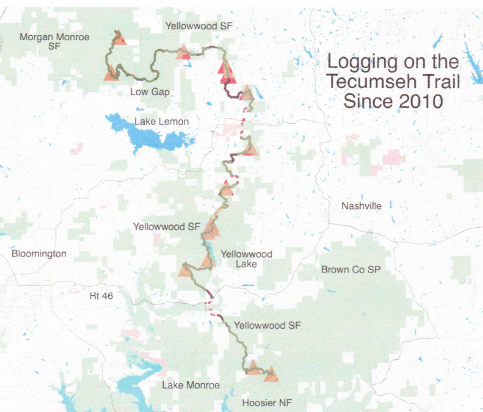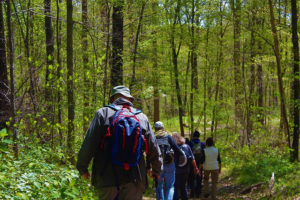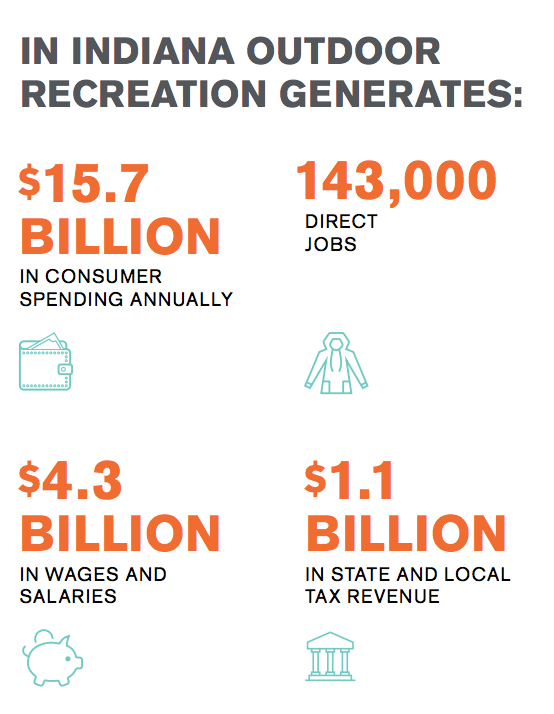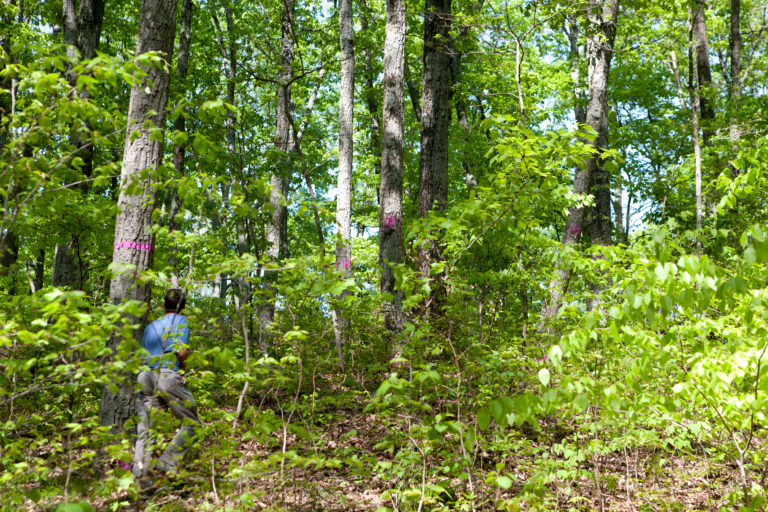by Anne Laker
Every backcountry trail I’ve hiked in Indiana has had evidence of logging…Even though I live in Indiana, I prefer to hike in neighboring states just to avoid having to witness it.”
We recently moved to Indiana from Vermont and were appalled by the logging/erosion at Yellowwood. Hiking there was depressing.”
These two comments made on IFA’s Facebook page beg the question: Why is Indiana wrecking our finest eco-tourism assets? Can we afford to?
 Indiana’s 13 state forests- all but one of them in the southern half of the state- are the only state properties where visitors are allowed to hike and camp off trail, for a rustic experience of wild nature. With many of the state’s best hiking trails and only backpacking trails running through them, state forests should be the go-to places for outdoor recreation. But logging on state forests has increased 400% since 2002. The state has prioritized logging in state forests over recreational use, when they were created for mixed use.
Indiana’s 13 state forests- all but one of them in the southern half of the state- are the only state properties where visitors are allowed to hike and camp off trail, for a rustic experience of wild nature. With many of the state’s best hiking trails and only backpacking trails running through them, state forests should be the go-to places for outdoor recreation. But logging on state forests has increased 400% since 2002. The state has prioritized logging in state forests over recreational use, when they were created for mixed use.
Contrast this with our popular state parks, which are characterized by miles of paved roads, developed playgrounds, man-made lakes, etc. In our state nature preserves and the portions of state parks left to nature, hikers are not permitted to explore off trail. Primitive camping is only allowed in two of the 25 state parks. Other activities such as mushroom foraging are not allowed at all.
The popularity of Indiana state parks proves that Hoosiers are starved for outdoor recreation. Hoosiers ranked hiking as one of their most favorite forms of outdoor recreation in four of the last five outdoor participation surveys in the DNR’s Statewide Comprehensive Outdoor Recreation Plan. A primary reason that Hoosiers did not use trails was: structural barriers-poor setting/physical environment. Both the Knobstone Trail in Scott County and the Tecumseh Trail in Monroe/Brown/Morgan Counties should be Indiana’s version of the Appalachian Trail. Instead, the Tecumseh, for example, has been logged over in 14 places in the last 7 years, resulting in trail closures and re-routes.
In addition to closing trails, logging in the state forests is turning beautiful areas of wild nature into aesthetically unattractive sites that depress visitors and discourage return visits to state forests.
 Thus, Indiana is missing tourism opportunities. According to the latest US Census Data, more than two million people live within 20 miles of Indiana’s state forests and more than 14.5 million people live within 100 miles of our state forests. If the state forests were seen as desirable destinations, more outfitters, bed & breakfasts, and cafes would spring up. The 59% of Hoosiers who participate in outdoor recreation are an untapped market for our state forests.
Thus, Indiana is missing tourism opportunities. According to the latest US Census Data, more than two million people live within 20 miles of Indiana’s state forests and more than 14.5 million people live within 100 miles of our state forests. If the state forests were seen as desirable destinations, more outfitters, bed & breakfasts, and cafes would spring up. The 59% of Hoosiers who participate in outdoor recreation are an untapped market for our state forests.
Tourism leaders like Mike McAfee, executive director of Visit Bloomington, are taking notice:
“We target visitors that want to make the world a better place and I do not think there could be a stronger example of that than outdoor recreation enthusiasts or what we call our ‘Health Nut Set.’ The more we keep our forests pristine and wild and take care of them, the more valuable and attractive they are. It is a special balance but the forest is only sustainable as an eco-tourism asset if it is intact. Traffic on our website to our Monroe Lake section is up 780% this year if that is any indication to you how popular outdoor adventure is in this region.
Monroe County’s trees, hills, water and wildlife are priceless natural resources that we must preserve and we are against any activities, including logging, that curtail people’s enjoyment of the outdoors. We urge Governor Holcomb and the Indiana Department of Natural Resources to seek every possible alternative before allowing further logging or developments in Indiana state forests or any locations where people enjoy wilderness experiences.
Likewise, the executive director of the Brown County Convention & Visitors Bureau, Jane Ellis, sent a strong message to Governor Eric Holcomb this month:
 I would like to take this opportunity to express Brown County’s dissatisfaction with the logging practices that have been taking place in Yellowwood State Forest. As one of Indiana’s most forested areas, we value the natural beauty that surrounds us, as well as understand the importance it has upon our local economy. Each year, millions of individuals visit Brown County, a large majority of whom come specifically to admire and explore our natural resources. As the Brown County CVB, we also have spent a significant amount of money on promoting our beautiful scenery and outdoor opportunities through an extensive outdoor marketing campaign?
I would like to take this opportunity to express Brown County’s dissatisfaction with the logging practices that have been taking place in Yellowwood State Forest. As one of Indiana’s most forested areas, we value the natural beauty that surrounds us, as well as understand the importance it has upon our local economy. Each year, millions of individuals visit Brown County, a large majority of whom come specifically to admire and explore our natural resources. As the Brown County CVB, we also have spent a significant amount of money on promoting our beautiful scenery and outdoor opportunities through an extensive outdoor marketing campaign?
However, the recent logging that has taken place in Yellowwood has hurt the State Forest’s reputation. We have heard negative feedback from many visitors who have been to Yellowwood State Forest either on their own accord or based on our recommendation. Not only is this hindering interest and visitation to Yellowwood, but if it continues, it could possibly negatively impact Brown County’s notoriety as a premiere outdoor destination, as well as revenue generated by tourism. We ask that you please have respect for Brown County’s natural resources as a steward for Indiana’s forests.
In a place as naturally beautiful as southern Indiana, forests in their purest form are the renewable resources we should invest in — by simply leaving some of them as nature intended.

